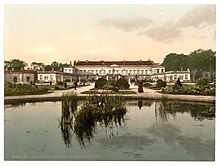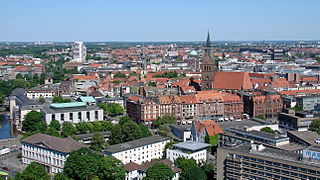
Hanover is the capital and largest city of the German state of Lower Saxony. Its 535,932 (2021) population makes it the 13th-largest city in Germany as well as the fourth-largest city in northern Germany after Berlin, Hamburg and Bremen. Hanover's urban area comprises the towns of Garbsen, Langenhagen and Laatzen and has a population of about 791,000 (2018). The Hanover Region has approximately 1.16 million inhabitants (2019) and is the largest in the Hannover–Braunschweig–Göttingen–Wolfsburg Metropolitan Region.

Sophia was Electress of Hanover from 19 December 1692 until 23 January 1698 as the consort of Prince Elector Ernest Augustus. She was later the heiress presumptive to the thrones of England and Scotland and Ireland under the Act of Settlement 1701, as a granddaughter of King James VI and I. Sophia died less than two months before she would have become Queen of Great Britain and Ireland. Consequently, her son George I succeeded her first cousin once removed, Queen Anne, to the British throne, and the succession to the throne has since been defined as, and composed entirely of, her legitimate and Protestant descendants.

The Georgengarten is a landscape garden in the northwestern borough of Herrenhausen of the German city Hanover. It is a part of Herrenhausen Gardens.
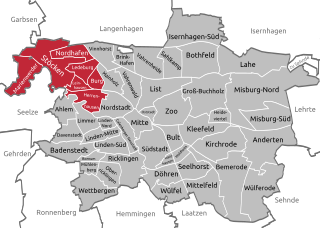
Herrenhausen-Stöcken is a borough of the German city of Hanover, northwest of the city centre. In 2020 it had a population of 37,543. It consists of the quarters Burg, Herrenhausen, Ledeburg, Leinhausen, Marienwerder and Stöcken.

The House of Hanover is a European royal house with roots tracing back to the 17th century. Its members, known as Hanoverians, ruled Hanover, Great Britain, Ireland, and the British Empire at various times during the 17th to 20th centuries. Originating as a cadet branch of the House of Welf in 1635, also known then as the House of Brunswick-Lüneburg, the Hanoverians ascended to prominence with Hanover's elevation to an Electorate in 1692. In 1714 George I, prince-elector of Hanover and a descendant of King James VI and I, assumed the throne of Great Britain and Ireland, marking the beginning of Hanoverian rule over the British Empire. At the end of his line, Queen Victoria's death in 1901, the throne of the United Kingdom passed to her eldest son Edward VII, a member of the House of Saxe-Coburg and Gotha, through his father Albert, Prince Consort. The last reigning members of the House of Hanover lost the Duchy of Brunswick in 1918 when Germany became a republic.

The House of Welf is a European dynasty that has included many German and British monarchs from the 11th to 20th century and Emperor Ivan VI of Russia in the 18th century. The originally Franconian family from the Meuse-Moselle area was closely related to the imperial family of the Carolingians.
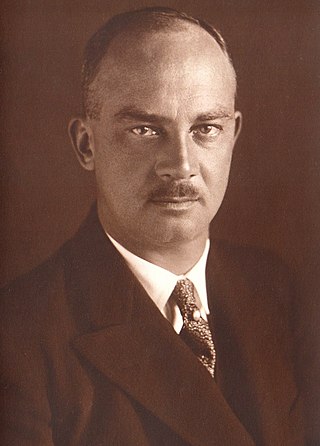
Ernest Augustus ; 17 November 1887 – 30 January 1953) was Duke of Brunswick from 2 November 1913 to 8 November 1918. He was a grandson of George V of Hanover, thus a Prince of Hanover and a Prince of the United Kingdom. He was also a maternal grandson of Christian IX of Denmark and the son-in-law of German Emperor Wilhelm II. The Prussians had deposed King George from the Hanoverian throne in 1866, but his marriage ended the decades-long feud between the Prussians and the Hanoverians.

Ernst August, Hereditary Prince of Brunswick, Prince of Hanover was head of the House of Hanover from 1953 until his death in 1987. From his birth until the German Revolution of 1918–1919 he was the heir apparent to the Duchy of Brunswick, a state of the German Empire.

Ernest Augustus, Duke of Brunswick-Lüneburg, was Prince of Calenberg from 1679 until his death, and father of George I of Great Britain. He was appointed as the ninth prince-elector of the Holy Roman Empire in 1692.

The Electorate of Hanover was an electorate of the Holy Roman Empire, located in northwestern Germany and taking its name from the capital city of Hanover. It was formally known as the Electorate of Brunswick-Lüneburg. For most of its existence, the electorate was ruled in personal union with Great Britain and Ireland following the Hanoverian Succession.
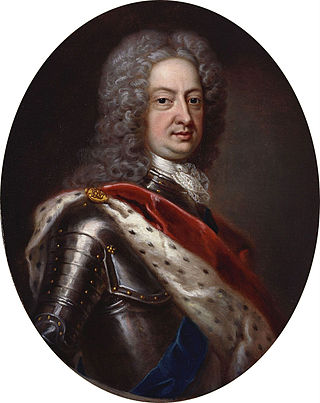
Ernest Augustus, Duke of York and Albany, was the younger brother of George I of Great Britain. Ernest Augustus was a soldier and served with some distinction under Emperor Leopold I during the Nine Years' War and the War of the Spanish Succession. In 1715, he became Prince-Bishop of Osnabrück.

The Herrenhausen Gardens of Herrenhausen Palace are located in Herrenhausen, an urban district of Hanover, the capital of Lower Saxony, Germany. Dating to the era of the Kings of Hanover, they comprise Great Garden, Hill Garden, Georgen Garden and Guelf Garden.
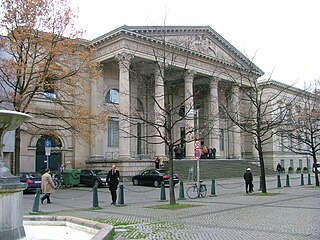
The Leineschloss, situated on the Leine in Hanover, Germany, is the former residence of the Hanoverian dukes, electors and kings. Currently it is the seat of the Landtag of Lower Saxony.

Ernst August, Hereditary Prince of Hanover is the eldest child of Ernst August, Prince of Hanover, and his first wife Chantal Hochuli. Due to his father's second marriage, he is also the stepson of Caroline, Princess of Hanover, a Monegasque Princess and the sister of Albert II of Monaco.
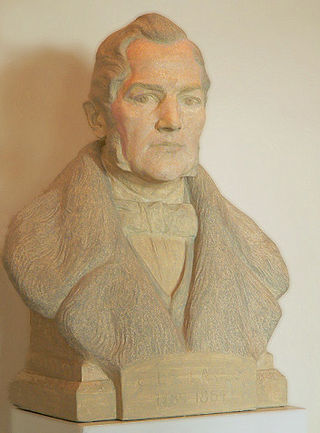
Georg Ludwig Friedrich Laves was a German architect, civil engineer and urban planner. Born in Uslar, Lower Saxony, he lived and worked primarily in the city of Hanover and also died there. He was appointed Oberhofbaudirektor, "court master builder", in 1852. As the leading architect of the Kingdom of Hanover for a career spanning 50 years, he had great influence on the urban development of this city. Alongside Karl Friedrich Schinkel in Berlin and Leo von Klenze in Munich, Laves was one of the most accomplished neoclassical style architects of Germany. As an engineer he developed a special iron truss lenticular or "fishbelly" beam bridge construction method, the so-called "Lavesbrücke". Laves found his final resting place in the Engesohde Cemetery in Hanover.

Marienburg Castle is a Gothic revival castle in Lower Saxony, Germany. It is located 15 kilometres (9.3 mi) north-west of Hildesheim, and around 30 kilometres (19 mi) south of Hannover, in the municipality of Pattensen, Hannover. It was also a summer residence of the House of Welf whose flag flies on the main tower.

The Hill Garden is a historic botanical garden, one of the gardens of the Herrenhäuser Gärten, around the residence Herrenhäuser Schloss in Herrenhausen, now part of Hanover, Lower Saxony, Germany. The garden was first created in 1666 as a vegetable garden on a hill north of the palace, and then transformed into a garden for exotic plants. In 1750, it was developed into a botanical garden, with some unusual trees from the period still surviving. It features a palm house, first built in 1846, and a mausoleum, where members of the royal family were interred. Damaged by air raids in World War II, the gardens were restored. In 2000, a house for rain forest-themed gardens was added, which was transformed to an aquarium in 2007.

Pillnitz Palace is a restored Baroque schloss at the eastern end of the city of Dresden in the German state of Saxony. It is located on the right bank of the River Elbe in the former village of Pillnitz. It was the summer residence of many electors and kings of Saxony; it is also known for the Declaration of Pillnitz in 1791.

Girolamo Sartonio, also known as Hieronimo Sartorio and Geronimo Sartorio, was an innovative Italian architect and engineer who worked mainly the German cities of Hanover, Hamburg, Leipzig and Erfurt. His designs were based on Palladian architecture. He was a noted expert in the installation of stage equipment and theatrical machinery and also worked as a builder or consulting architect on the construction of various opera houses, such as the Oper am Gänsemarkt in Hamburg. He is also credited with the beginnings of opera in Leipzig and the construction of the opera house in Prague.

The Welfenschloss is a former royal palace in Hanover, Germany, which serves as the main building of the Leibniz University Hannover. The university is housed in the palace since 1879. The palace is surrounded by a large English landscape garden, named the Welfengarten.
